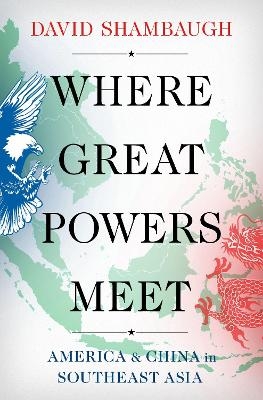
Where Great Powers Meet
Oxford University Press Inc (Verlag)
978-0-19-091497-4 (ISBN)
After the end of the Cold War, it seemed as if Southeast Asia would remain a geopolitically stable region within the American imperious for the foreseeable future. In the last two decades, however, the re-emergence of China as a major great power has called into question the geopolitical future of the region and raised the specter of renewed of great power competition.
As the eminent China scholar David Shambaugh explains in Where Great Powers Meet, the United States and China are engaged in a broad-gauged and global competition for power. While this competition ranges across the entire world, it is centered in Asia, and in this book, Shambaugh focuses the ten countries that comprise Southeast Asia. The United States and China constantly vie for position and influence in this enormously significant region-and the outcome of this contest will do much to determine whether Asia leaves the American orbit after seven decades and falls into a new Chinese sphere of influence. Just as importantly, to the extent that there is a global "power transition" occurring from the US to China, the fate of Southeast Asia will be a good indicator. Presently, both powers bring important assets to bear. The US continues to possess a depth and breadth of security ties, soft power, and direct investment across the region that empirically outweigh China's. For its part, China has more diplomatic influence, much greater trade, and geographic proximity. In assessing the likelihood of a regional power transition, Shambaugh at how ASEAN (the Association of Southeast Asian Nations) and the countries within it maneuver between the United States and China and the degree to which they align with one or the other power.
Not simply an analysis of the region's place within an evolving international system, Where Great Powers Meet provides us with a comprehensive strategy that advances the American position while exploiting Chinese weaknesses.
David Shambaugh is Gaston Sigur Professor of Asian Studies, Political Science, & International Affairs and the founding Director of the China Policy Program in the Elliott School of International Affairs at George Washington University. He is an internationally recognized authority and award-winning author on contemporary China and the international relations of Asia. An active public intellectual and frequent commentator in the international media, he serves on numerous editorial boards, and has been a consultant to governments, research institutions, foundations, universities, corporations, banks, and investment funds. As an author, Professor Shambaugh has published more than 30 books and 300 articles.
List of Figures
List of Tables
Preface
Chapter 1: Sino-American Competition in Southeast Asia
Part I: The American Encounter with Southeast Asia
Chapter 2: America's Legacies in Southeast Asia
Chapter 3: America's Contemporary Roles in Southeast Asia
Part II: The Chinese Encounter with Southeast Asia
Chapter 4: Chin a's Legacies in Southeast Asia
Chapter 5: Contemporary China's Roles in Southeast Asia
Part III: Southeast Asian Encounters with America and China
Chapter 6: Navigating Between the Giants: ASEAN's Agency
Part IV: The Future of Great Power Relations in Southeast Asia
Chapter 7: Sino-American Competition in Southeast Asia: Polarization or Competitive Coexistence?
Acknowledgments
Notes
Index
| Erscheinungsdatum | 15.01.2021 |
|---|---|
| Verlagsort | New York |
| Sprache | englisch |
| Maße | 236 x 165 mm |
| Gewicht | 658 g |
| Themenwelt | Sozialwissenschaften ► Ethnologie |
| Sozialwissenschaften ► Politik / Verwaltung ► Europäische / Internationale Politik | |
| Sozialwissenschaften ► Politik / Verwaltung ► Staat / Verwaltung | |
| Sozialwissenschaften ► Politik / Verwaltung ► Vergleichende Politikwissenschaften | |
| Sozialwissenschaften ► Soziologie | |
| ISBN-10 | 0-19-091497-1 / 0190914971 |
| ISBN-13 | 978-0-19-091497-4 / 9780190914974 |
| Zustand | Neuware |
| Informationen gemäß Produktsicherheitsverordnung (GPSR) | |
| Haben Sie eine Frage zum Produkt? |
aus dem Bereich


